
NFT’s Place In The World Of The Future
Everyone in the cryptocurrency market, in one way or another, when reads sale news about NFT assets or spends time on platforms such as Opensea, even once they think, “Is NFT really worth that much?” . In this article, in which unsubstantial studies that have no cultural, artistic or functional features and try to take advantage of the liquidity in the market are left aside, the future perspective expressed by NFT products is examined as a whole through virtual reality (VR), augmented reality (AR) and metaverse platforms.
Abbreviations and Definitions
Virtual Reality: This concept allows users to experience the virtual world with devices such as VR headsets. With these devices, users are in a sort of simulation. In the rest of the article, this technology will be mentioned as VR.

Augmented Reality: It is the presence of virtual objects in the physical world through applications installed on devices such as phones and tablets. Virtual objects can be viewed with the devices’ cameras. In the rest of the article, this technology will be mentioned as AR.
Metaverse: It is a kind of virtual world. NFT can provide various functionalities to assets on these worlds.
Functionality
Internet cafes, which were quite common in the past, have lost their popularity along with the introduction of computers and the internet in every home. In today’s world, where technology is advancing at a dazzling pace, games played in the virtual world in specially designed rooms by wearing VR headset, particularly in metropolitan cities, have started to become popular. Similar to internet cafes, we can say that VR technology is undergoing a transition period before full integration.
In the image below, one of the most notable trial versions of VR technology was the virtual meeting of a mother with her deceased daughter through a VR headset. Below is an image from that meeting. For this meeting, an exact copy of the girl was created in the virtual environment.
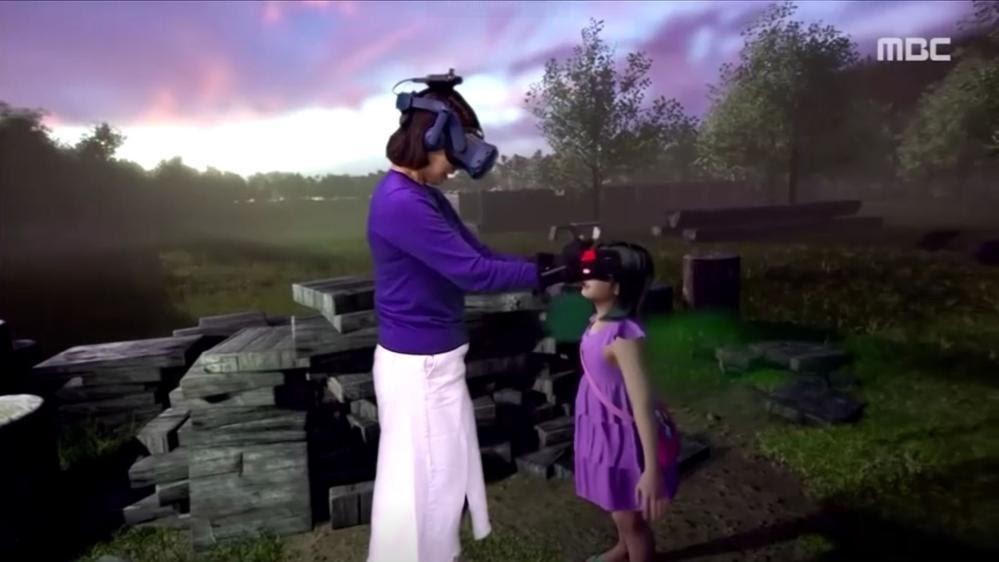
While VR technology is developing rapidly in different areas, AR technology has made rapid progress in the field of marketing. Nowadays, where almost everyone is shopping online, shopping especially in the areas of clothing and furniture brings with it doubts about how an outfit will look on you or whether the sofa will fit in your living room. Brands integrating AR technology into their applications offer a solution to the problem by combining high technology with shopping, allowing you to test all these products on your phone in full size.
Augmented Reality
While AR and VR technologies are beginning to occupy a significant place in our daily lives, it is unimaginable for such a virtual world to develop independently of cryptocurrencies. For AR, in particular, it can be easily understood what NFT means for this technology. A platform that sells NFT products and also integrates AR infrastructure into its application, can visualize purchased artworks — for instance, how they stand on the wall of the house or how a wearable NFT product looks on the user- through AR. However, seeing NFTs solely from a phone or tablet camera is not sufficient in terms of functionality. At this point, AR glasses (the following is visual AR glasses produced in cooperation with Facebook and Ray-Ban) can ensure that NFT assets can be constantly seen in the real world and fixed at the location where they are located.

Let’s expand on this issue a little more with an example. For example, applications such as OVR offer every piece of land in the world for sale in parcels. When a parcel is purchased, the use of virtual assets in the parcel is solely yours. Assume that the region where the Grand Bazaar is located is purchased through the application. The purchaser can put any NFT inside the bazaar or on its roof. This NFT can also be seen by another person using the same application. In this way, the NFT is fixed at a specific location.
Now, let’s back to the AR glasses pictured above. When we think that these glasses, which does not look very different from normal glasses, is used by everyone, such as smartphones, we can see virtual entities at every point of our daily life and start living with these entities, and we can see virtual entities on the Metrobus, on the subway, on the bridge, everywhere.
These entities should not be limited to items that come to mind first, such as artwork or furniture. For instance, the face filter below provides a kind of mask function and is described as a wearable NFT. These NFTs may in the future cause people to constantly walk around with various virtual masks or filters, due to AR glasses. When we consider the face filters in applications such as Instagram and Snapchat, it can be predicted that people will be quite willing to use filters that contain various tattoos or makeup, even if there is no such mask.
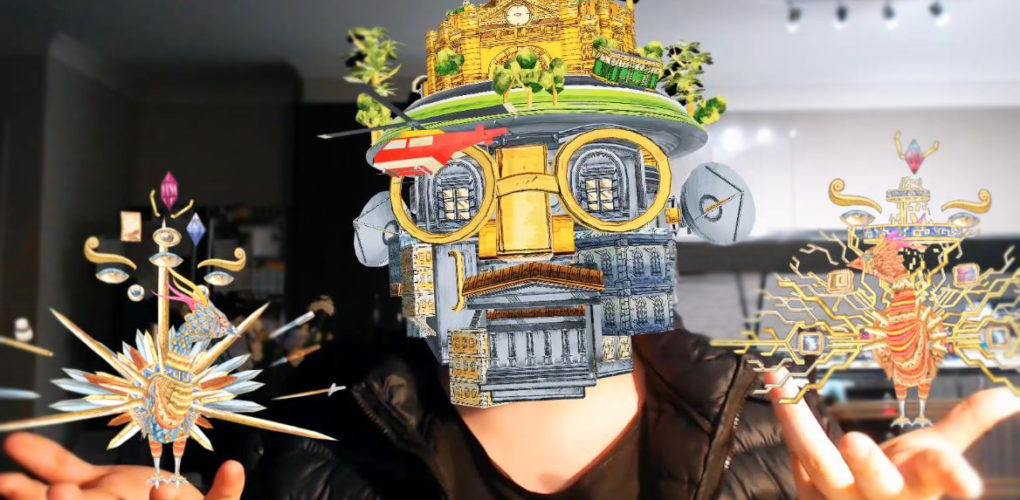
Considering that all clothes, accessories, and designs, which may be very difficult or costly to produce in real life can be worn with a digital design, it can be understood how wide range is being mentioned.
Other than that, we can say that NFTs have the potential to create a very practical area of use for artists and artworks via AR. For example, since a painting made by Picasso is a very valuable work that needs to be protected very sensitively and finds buyers for high amounts, costs such as transporting this work from one country to another, insuring it in high amounts during transportation can be minimized by virtue of NFT. Works to be displayed at an auction or exhibition, if copied as NFT, can be seen in extreme detail by AR glasses at these exhibitions. In this way, these works do not need to be transported or insured for each event. In this way, the works can participate in more events and be shown in more than one place at the same time. Not only physically present works, but also digitally created artworks can also be displayed in this way and become a part of the real world.
Metaverse
The subject of AR can be further diversified with a wide variety of virtual entities from the perspective above. So how can VR technology be used with NFT assets? For the answer to this question, first of all, it is necessary to talk about metaverse platforms. Metaverse platforms are virtual worlds similar to the computer game The Sims. Cities and regions here do not have to look like real-life regions. There are also platforms that have a completely unique structure. It is entirely up to your decision and imagination to purchase parcels on these platforms generally integrated into the Ethereum network and build any structure that can operate as a house, workplace, or cultural activity on this parcel. On platforms such as Decentraland, Sandbox, CryptoVoxels, which are among the most popular platforms, it is possible to see shopping mall-like structures, concert venues, exhibitions, houses, cars, etc. It is possible to connect to these platforms after integrating a blockchain wallet such as Metamask and then navigate the metaverse world with an avatar of your own. Moreover, it is possible that you will purchase every single asset you encounter in this world as NFTs.
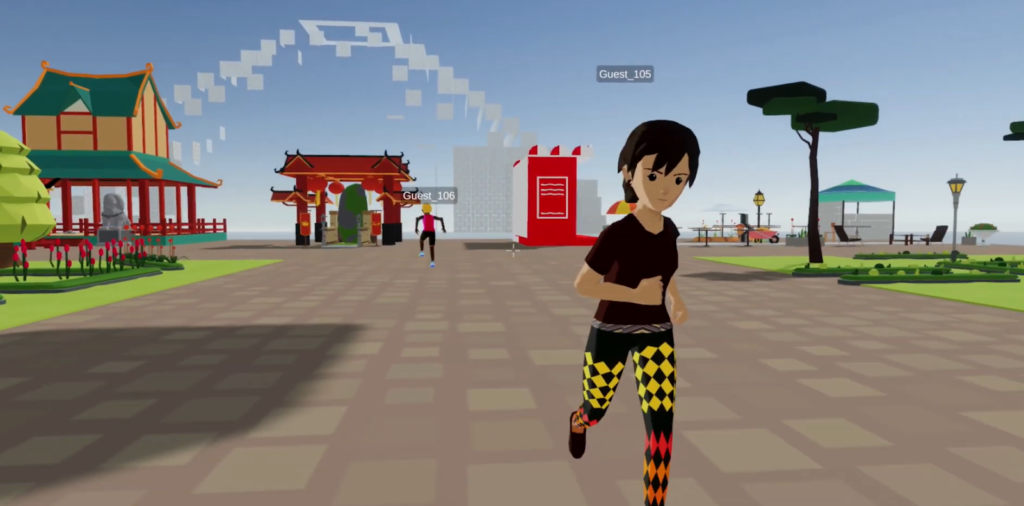
The economic potential of Metaverse platforms is also quite impressive. Although there are stores selling t-shirts and shorts in these worlds like in real life, the most impressive part is that these platforms can have an intertwined relationship with other digital sectors. The most prominent sector in this regard is undoubtedly the gaming sector. Just as we can buy t-shirts from the store in real life and wear them on us, for instance, a person playing PUBG can also go shopping on one of the metaverse platforms with their avatar from a shop that sells only PUBG shoes or weapons, and use the products they buy in the PUBG character.
Considering our real-life body can also be an avatar, we can understand that the metaverse is actually a new industry that is still in the very early stages of development as a copy of the real world.
This sector is very significant not only for the use of NFTs on the virtual platform but also for creating new business lines. In a new city, “digital real estate consultancy” is formed about which parcels are more popular or have the potential to be valued more. In addition, for example you can hang a billboard on the wall of your virtual building and generate income. Hence, we can predict that digital versions of sectors such as advertising and real estate will increase in the metaverse world. The digital real estate that a digital real estate investment firm bought from the Decentraland metaverse platform for 1.3 million MANA ($913,808) on June 18, 2021, is a good example. Another similar example is the Mars themed house seen in the image below. Located on the CryptoVoxels metaverse platform, this house has been sold for $500,000.

Likewise, wearable NFTs produced with special designs can enable the clothing industry to become a digital brand. As a matter of fact, Atari, which we know from the gaming industry, has developed a shoe in the form of NFT to be used in new games to be released on the basis of blockchain.
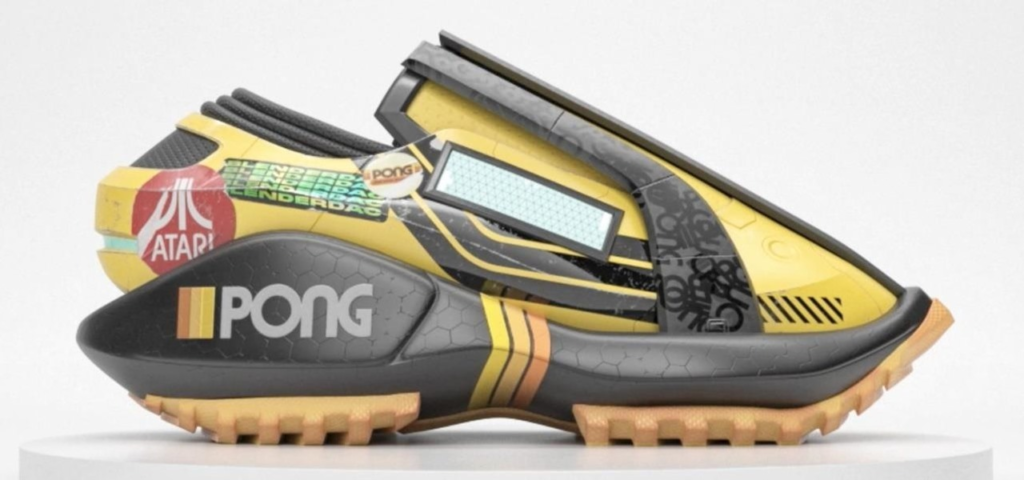
Metaverse platforms have different designs and strategies among themselves. For instance, Cryptovoxels has a simpler but cultic design, while Decentraland is a metaverse platform with a design similar to computer games. Apart from the technological competition of these platforms with each other, the design differences they have may also cause the users to differentiate in the future, similar to music genres. To set an example, a person who prefers the Decentraland platform may not want to use the Sandbox platform, just as a person who listens to rock music does not get the same pleasure from a classical music concert.
Virtual Reality
We briefly mentioned in the definition section that Virtual Reality includes experiencing a virtual world through accessory devices such as VR headsets and gloves, and experiencing a real-like feeling while walking and touching in this world. In the future, it is also expected to develop a system that addresses the senses of taste and smell as well. In this regard, VR is actually quite similar to the metaverse universe in the previous article. The only difference is that while it is possible to physically experience this experience with devices such as glasses in VR technology, metaverse platforms do not yet offer such an opportunity. However, when it is possible to travel in the metaverse world with the devices used in VR technology in the future, there may be a complete combination with AR technology that we can use in the real world currently. This perspective is well visualized in the sample video Microsoft has posted on the subject.
In the video, we generally see the real-life locations of AR technology and virtual assets, however, if attention is paid to the scene at 1.50 minutes, the players in the video transition to a virtual world and can navigate in this world. In this scene, let’s think of the virtual world where the players are transferred as a metaverse. In the future when technology is fully developed, we can live with AR glasses constantly intertwined with virtual assets, meet our needs by crossing into the metaverse world for any virtual asset exchange, and return back to the real world, just as shown in the video.
Considering that this virtual world and the assets on all these platforms must have an economy, there is currently no better alternative than cryptocurrencies.
Branding and Corporateness
The branding of a commercial or public institution, its positive or negative appearance in the eyes of the public, is directly proportional to the success of the investments and advertising strategies of these institutions. We can say that the brands that have dominated the market for more than 100 years are always highly respected.
The NFT sector, as mentioned in the examples above, offers these brands a new investment and advertising market. This market is very significant for the prestige of both commercial and public institutions, particularly since it appeals to the new generation. It is an indisputable fact that brands that want to take risks in this area and start their virtual world integration from somewhere have a perspective that can affect decades later.
The recent NFT breakthrough by the US Space Force can be seen as one of the most striking examples of the subject. Dedicated to the astronaut Neil Armstrong, who walked on the moon for the first time, the new military and civilian satellite to be sent into space, has been transferred to NFT form as a result of the cooperation of the US Space Forces with WorldwideXR and VueXR companies, and has been made available for use in the metaverse world. Since the concept of space itself directly evokes technology and the future, making such initiatives is also very appropriate and inspired in terms of the characteristic feature of the NFT industry.
Another example is that Gucci, one of the world-famous brands, produces its own virtual shoes, similar to Atari’s wearable shoe design, which we have mentioned at the above of the article. You can try this shoe virtually with AR technology through Gucci’s own app.
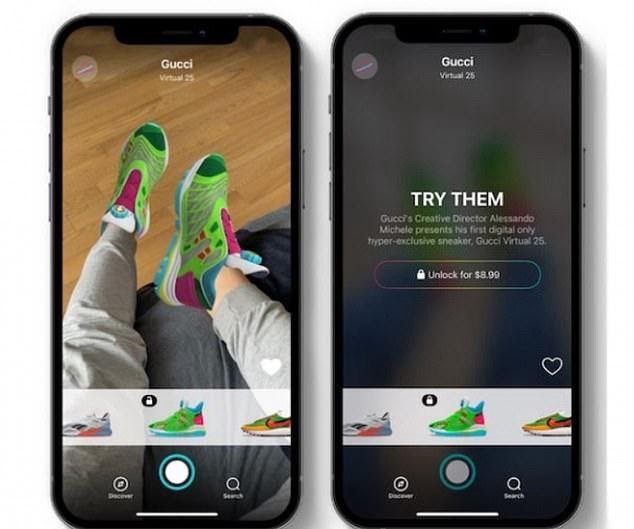
If the above-mentioned future perspectives are realized, Gucci will have the chance to sustain to be one of the most prestigious brands for the younger generation by catching the market in the new virtual world owing to its current investments. For this reason, it can be expected that brands that want to catch up with the new generation and achieve a sustainable brand target will be increasingly interested in the NFT sector.
Market Data
There are several popular platforms operating in the metaverse. The market values of these platforms within the sector are as follows, according to the first quarter result of 2021.
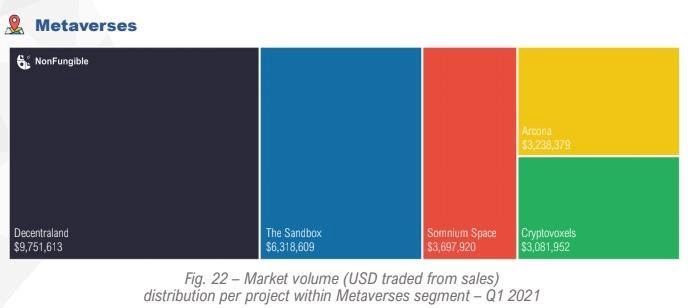
Conclusion
The NFT sector is a newly burgeoning sector that has quickly established a field of use. Just as the ability of cryptocurrencies to perform secure financial transactions on the internet without intermediaries is a financial revolution, NFT’s definition of “belonging” to each virtual asset with a “deed-like” feature is a development of almost the same importance. It should also be indicated that; all the above-mentioned AR-VR-based systems can be produced quickly and effectively by technology companies such as Microsoft and Facebook, which have huge data sizes. However, the important thing is that NFT assets cannot be reproduced or changed in any way due to the decentralized nature of platforms such as Ethereum. Therefore, no matter how great the trust brought by decentralization is, it cannot be provided by other technology companies. The creation of this technology on decentralized platforms is therefore necessary both for security and for the general acceptance of the community.
One of the most significant reasons for the rapid adaptation of the NFT industry is games. The new generation that grew up with the computer and Playstation is not surprised when it encounters avatars, objects, and metaverse worlds similar to the games it plays, and they can adapt very quickly. Thanks to games, metaverse platforms are familiar platforms for the new generation as they experience an atmosphere they are already in.
In conclusion, let’s remember how fast the Pokemon Go game, which has been popular in the past years, has suddenly developed due to AR technology and many people are trying to hunt Pokemon with their mobile phone cameras. It may be thought that Pokemon has a much faster interaction thanks to its brand value, however, the important thing is that so many people can play this game all over the world and adapt to AR technology so quickly.
The speed at which metaverse platforms, fully developed and integrated with AR-VR, become a part of our daily lives in the coming years may astonish everyone.
Written By: Berkay Aybey
The opinions and comments expressed here belong to BV Crypto. BV Crypto cannot be held responsible for any financial transactions made on the basis of this post. Every investment and trading move involves risk. When making your decision, you should do your own research.
